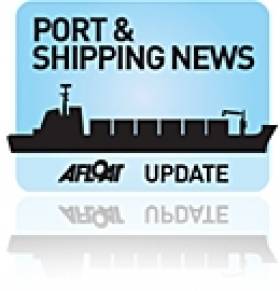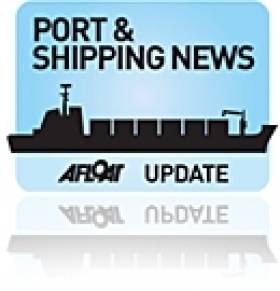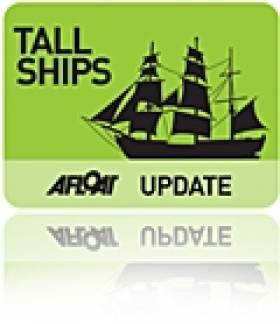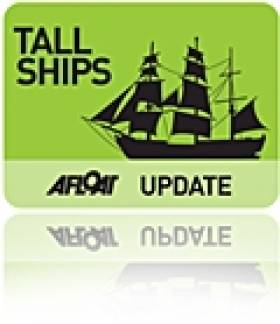Displaying items by tag: TallShips
'Gift of Youth' Set to Sail into Dublin Bay
#TallShips – This Thursday the tallship Dar Mlodziezy, a fully rigged A class sail-training vessel of the Gdynia Maritime University (a state run Maritime academy) is due to visit Dublin Port for two days, writes Jehan Ashmore.
An English translation of her name means "The Gift of Youth" which is appropriate given that the ship built in 1982 at the Polish city of Gdansk on the Baltic Sea, was completed with funding partly financed by the gifts of young school-children.
Designed by Zygmunt Choren, she is specifically constructed to train cadets of the Polish marine and she has taken part in The Tall Ship Races over the years.
Some of her main specifications are detailed as follows: Length: 110.6 m Beam: 14 m Draught: 6.6m Height of tallest mast 62.1 m Sails: 3.015 sq m Top speed under sail: 17.8 kt and she has a displacement of 2946 tons.
She has a crew of 40 and where cadets that number up to 136 personnel are trained in seamanship skills. Should there be no wind, she is fitted 2 x 750 hp Cegielski-Sulzer engines which generate more than 12 knots.
Given the current spate of strong winds, this however should not pose an issue!
Currachs, Old Gaffers & Tallships to Gather in Dublin Bay Races over June Bank Holiday
#Currachs&Tallships – Three events are scheduled to take by place in Dublin Bay over the June Bank Holiday, writes Jehan Ashmore
As previously reported on Afloat.ie, Coliemore Harbour in Dalkey is where a pair of racing currachs for the Begnet's Boat Project are to be launched on Saturday (1 June) and rowed if not raced! across the sound to Dalkey Island.
The currachs are to be constructed locally with the support of the community which is to foster and strengthen creative, spiritual and maritime links between the town (the former medieval port for Dublin) and Dalkey Island.
In addition the community are invited to take part in accompanying projects, one in which includes a 'St. Begnet's Cookbook' which features seafaring recipes by Elaine Flood which are to be put to good use in feeding the boat-building team during the month-long currach construction.
Currently there is a fundraiser campaign with a reward scheme, noting a countdown of only three days remain before closing date. To learn more about this project and to help in funding, click HERE.
The Old Gaffers Association (OGA) which as previously reported on Afloat.ie are to celebrate their Golden Jubilee, where also on Saturday (1 June) larger craft are to participate for the RMS Leinster Trophy from Dun Laoghaire Harbour and surrounding islands and buoys to Poolbeg Y & BC Ringsend.
On Sunday (2 June), the Howth 17's are also to join in the action on the Liffey with a 'race between the bridges' having set off from Poolbeg, where most of the Dublin OGA branch members are based.
On the following Monday, (3 June) is the race for the new OGA Asgard Trophy. The trophy is made from a variety of spare timbers saved by John Kearon, conservator of Erskine Childers' Asgard.
All being well, the gathering of the OGA's one design class of classically gaff-rigged boats should present a glorious sight in Dublin Bay, with fellow Old gaffers fleets joining in from the Isle of Man, Scotland and England as part of the Golden Jubilee's clockwise cruise circuit of the UK.
The third event is the arrival of six tallships from Belfast which are to descend in the capital port on Friday (31 May). They will remain in port over the four-day long inaugural Dublin Port River Festival, an initiative of Sail Training Ireland.
This can only add to a sea of masts, albeit not like last year's Tall Ships Festival, yet however is still something to look forward... during those early days of June.
Ports & Shipping Review: Fenit’s Crane Exports, Cork’s Energy Deal, Belfast’s Tonnage Record, Grounded Airbus Wingship Re-floated plus more…
P&SReview – Over the last fortnight, Jehan Ashmore has reported from the shipping scene, where the Stade, a cargo vessel rode out bad weather before docking at Fenit to load cranes built by Liebherr in Killarney, which as previously reported has received an order from the New Zealand port of Lyttelton.
The Port of Cork Company have signed up with Sustainable Energy Authority of Ireland (SEAI) in targets for improved energy efficiency set for 2020.
Drogheda Port handled over 1m tonnes of cargo, this level in throughput has not been surpassed since 2007. The Co. Louth port is to welcome a flotilla of tallships during the Drogheda Fringe Festival over the May Bank holiday.
For the first time, Paris will host this year's European (Shortsea '13) Conference on 14 March at La Defense. Last year the IMDO hosted the event in Dublin's Mansion House.
Ports across Europe urged governments not to touch the envelope of €31.7billion foreseen for Europe's transport infrastructure investments under the Connecting Europe Facility (CEF).
Belfast Harbour had a record 19.6m tonnes in 2012, up 11% on the previous year. The growth was primarily driven from the bulk and roll-on/roll-off (freight) sectors.
Irish Ferries fast-craft catamaran Jonathan Swift, returned fresh from dry-docking, she operates the Dublin-Holyhead route, where she clocks up an impressive 162,000kms each year.
A grounded ship that carries wings for the Airbus A380, Ciudad de Cadiz (2008/15,643grt) was re-floated yesterday, having broke moorings during a gale in late January off the Welsh port of Mostyn.
Tallships to Visit Festival in Drogheda Port
#DroghedaTALLSHIPS – Drogheda Port is to welcome an inaugural gathering of tallships during the Drogheda Fringe Festival in May, writes Jehan Ashmore.
The sight of these tallships heading up the Boyne and to berth along the town's quay's, will be eagerly awaited and with the sense of adventure that goes with it.
The public will be able to board the six tallships along the Ballast and Deepwater Quays, on the Bank Holiday weekend of (4-5 May), before the flotilla head for Liverpool.
In fact, Drogheda, is the first port of call for these vessels which are also to visit Dublin, Belfast, Cobh, Gloucester, Liverpool, Whitehaven and Warrenpoint during May and June.
The visit of the tallships to the Co. Louth port, as previously reported on Afloat.ie, is part of Sail Training Ireland's programme of sail training voyages in 2013, where there are more than 500 berths available, for details visit this LINK. It will also be possible to book a passage from Liverpool to Drogheda on one of these traditional sailing ships, just as it was in the 1800's!
Paul Fleming CEO said "Drogheda Port Company is delighted to be hosting the inaugural Tall Ships event. The port has a commercial heritage going back to 1790 and a historical one much further. The soft values of seaports are incredibly important to their local area, and the port community is fully supportive to the opening up of the town to tourism and recreation through the river and our port.
Following on from the first ever cruise ship to call to Drogheda Port, with the arrival of the 122 passenger 'Clipper Adventurer' last year, port officials are pro-actively engaged with tourism interests with a view to developing maritime tourism infrastructure side by side with our important commercial activities.
"Port towns and cities stand apart, and by their nature tend to be more cosmopolitan and welcoming with a unique selling point for tourism. This year will be a significant maritime year for Drogheda, and the Boyne will continue to surprise and demonstrate its true value to the locality".
Local TD Gerald Nash said "the Tall Ships will give us a visual reminder of the past but also a glimpse into the future. We need to maximise the potential of our river in terms of tourism and leisure facilities." It will provide a huge boost to Drogheda not only in terms of visitor numbers and the knock on effect to the local economy, but also in terms of the sheer pleasure it will bring to the people.
Jeanie Presents Gifts Out of the Bottle
#TALLSHIP EVENTS– Once again the unique venue of the tallship Jeanie Johnston plays host to maritime heritage lectures and live music sessions throughout early 2013,writes Jehan Ashmore.
Resuming the 'Below the Surface' lectures series on 2 January will be a talk about Grace O'Malley - Ireland's Maritime Icon, one of history's most extraordinary mariners, presented by Anne Chambers.
A month later on 2 February, Juliet Turner a singer/songwriter from Tummery, near Omagh, launches the inaugural session of the New Year. In the course of her career she has opened up for artists among them Bob Dylan, U2 and Bryan Adams. Other performers lined-up for the Jeanie Sessions are Caroline Moreau and The Dunne & Hernandez Duo.
So if you are looking for a gift idea for the history buff or music lover in your life then perhaps consider as a stocking filler, which are available to purchase. For further information on lecture and gig tickets visit: www.jeaniejohnston.ie/events-page.html
The 'Jeanie' is berthed at Custom House Quay close to the Sean O'Casey foot-bridge in Dublin's city centre. In addition the replica 19th century barque is also a museum which tells the story of mass emmigration during the famine.
Sea Shanties Sessions Aboard the ‘Jeanie’
#MUSIC AFLOAT – Garland are returning to the Jeanie Johnston to perform more of their wonderful work songs and shanties!...this coming Saturday 17th November (open from 7.15 for start at 8pm).
Garland are a Dublin-based a capella group formed in 1970. The four-some are Pat Sheridan, Denis Ryan, Michael Andrews and Paul Noyes and forty years later they are still enthralling audiences with their exquisite four part harmonies.
A shanty is a type of work song that was once commonly sung to accompany labour on board large merchant sailing vessels. Shanties became ubiquitous in the 19th century era of the wind-driven packet and clipper ships.
The apt venue of the replica 19th century emigrant barque is where previous sessions have been held on board and from a wide variety of musical genres. The sessions take place below decks in the main saloon where space is strictly limited to 80 persons.
To locate the ship, she is moored on the north quays along Custom House Quay in the heart of the Dublin 'Docklands' quarter. For further information or to book tickets (€10) online click HERE
Ports & Shipping Review: Celtic Link Ferry 1st Year, Collision in Rosslare,Ports to Gain from Energy Sector, Volunteers for Tallship Dry-Docking and More...
#PORTS & SHIPPING REVIEW - Over the last fortnight Jehan Ashmore has reported from the shipping scene where Celtic Link Ferries celebrated their first year in service of the ro-pax ferry Celtic Horizon which operates the Rosslare-Cherbourg route.
Also in Rosslare, Stena Line's Fishguard ferry Stena Europe attempted to berth in high winds which led to the vessel making contact with the bow of Irish Ferries cruiseferry Oscar Wilde.
Further ferry news, though from Cork where last weekend saw the final end of season round-trip sailing to Roscoff operated by Brittany Ferries cruiseferry Pont-Aven.
According to the Irish Maritime Development Office (IMDO), Irish Ports are in a good position to capitalise on the growing demand for offshore renewable energy services.
Following the tallship Tenacious 'Open Day' in Dublin Port in late October, the 65m long barque returned to Dublin Bay, but instead made an overnight visit to Dun Laoghaire with 28 crew trainees on board. Her owners the Jubilee Sailing Trust are looking for volunteers to carry out tasks while she undergoes dry-dock this month.
Turnover in the Dublin Port Company has edged fractionally higher in 2011 at €69.1m and operating profit also slightly increased by €0.8m to €27.8m on 2010 figures.
An apt office location for Decisions (D4H) a software firm specialising in emergency response technology has made its new home at a building block adjacent of the Baily Lighthouse in Dublin Bay.
Volunteers Sought for Tallship that’s Going Bottom's Up!
#TALLSHIPS – What are the chances of getting to see the underside of a ship's hull, let alone the rare opportunity to carry out work on a tallship, look no further than the STV Tenacious, writes Jehan Ashmore.
This unique opportunity to see the hull exposed is to take place this month when the Jubilee Sailing Trust's 65m barque is to undergo anti-fouling work during an 18 day dry-docking. She has only been out of the water twice in the last five years.
Currently the vessel is berthed in Dun Laoghaire Harbour, though is to depart this morning bound for Milford Haven, her final port of call of a seven-day voyage, however she will remain in the Pembrokeshire port where there is a dry-docking facility.
If you can spare the time, volunteers would be most welcomed by the JST to help transform Tenacious, where a successful fundraising effort has raised funds to complete phase 1 of a routine refurbishment needed for the vessel.
Volunteers will be required to carry out the following jobs such as painting the hull, taking off and putting back the rudder, checking the anchors and chains, removing life-rafts for service, taking down yards and overhauling them.
Also involved will be the changing of the "cell" in the sewage plant and work on the master magnetic compass – otherwise known as replacing the "jewel".
So if you want to get up close and personal with a tallship –contact the JST on 00 44 (0)23 8044 9108 Email: [email protected] and by clicking HERE.
Tallship’s Dublin Call ‘Open’Day
#TALL SHIP- The tallship Tenacious which arrived yesterday to Dublin Port, is to host an Open Day to the public this Sunday 21st October at Sir John Rogerson's Quay, from 10am - 12.30pm and 2pm - 4pm.
The 65m barque is operated by the Jubilee Sailing Trust, and alongside her fleetmate Lord Nelson, are the only such tallships in the world that cater for trainee sailors of all physical abilities.
Sail Training Ireland have announced that there are limited places still available for this October's Tall Ship voyages around the Irish Sea aboard the vessel. For further details contact the Irish Branch of the JST on 01 496 0735 and in general by visiting www.jst.org.uk
Irish Sea Tallship Sailing Voyages
#TALLSHIP VOYAGES – There are three sailing voyages around the Irish Sea this October on board the Jubilee Sailing Trust's 65m barque Tenacious, the fleetmate of Lord Nelson which as previously reported, called to Dun Laoghaire recently, writes Jehan Ashmore.
The JST provides tallship training access to all able bodied and disabled sailors, from those aged 16-99 years and with no experience is necessary!
The three Irish voyages will include calling to ports in Belfast, Dublin and Waterford. Tenacious has 40 trainee places on each of the three voyages which will call to port and the JST is offering a "two-for-the-price-of-one" offer as well as discounted rates.
All offers have a discounted cost but if you would like to do two voyages you can pay brochure price for the first voyage and get the second voyage for free or alternatively bring a friend for free on any of the voyages.
Crew are needed to sail on the following voyages (please not prices in £ Pounds Sterling):
TNS356 Southampton - Dublin 11 - 20 October Brochure Cost: £775 Discounted Cost: £399 To book online click HERE
TNS357 Dublin - Belfast 22-28 October Brochure Cost: £525 Discounted Cost: £299 To book online click HERE
TNS358 Belfast - Milford Haven 29 October - 4 November Brochure Cost £525 Discounted Cost £299 To book online click HERE
For further information in general about the Jubilee Sailing Trust visit: www.jst.org.uk







































































